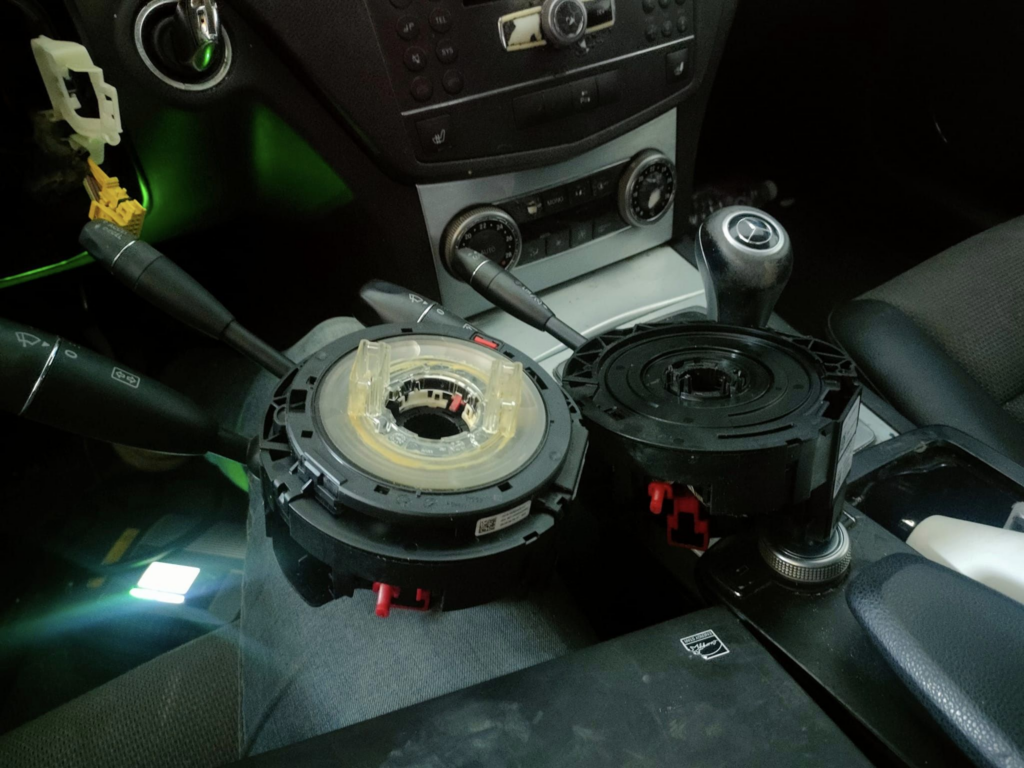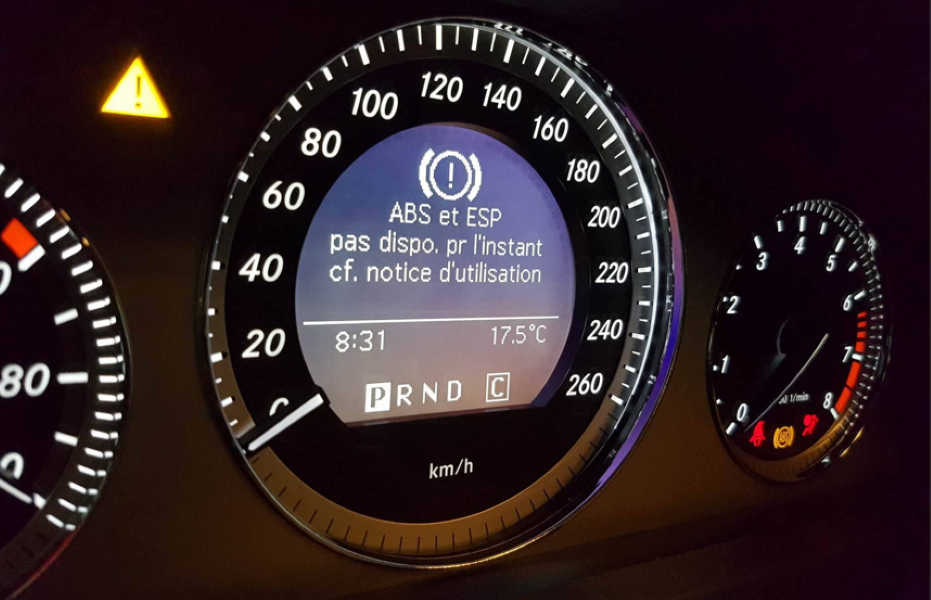Table of Contents
ABS and ESP Inoperative – Mercedes C-Class W204: Diagnosis & Fix
If your Mercedes C-Class W204 displays “ABS and ESP Inoperative – See Owner’s Manual”, it means two of your most important safety systems Anti-lock Braking System (ABS) and Electronic Stability Program (ESP) have been disabled due to a detected fault.
These systems work together to maintain traction, stability, and steering control during braking or cornering. Ignoring the warning can lead to longer stopping distances and loss of vehicle stability in emergency situations.
This case study shows how a certified Mercedes technician diagnosed and fixed this issue by addressing a faulty steering angle sensor, and includes a detailed DIY diagnostic guide and technical insights for enthusiasts and professionals.
For complete coverage of brake-related issues, visit our hub: Mercedes Brake System Problems: ABS, ESP & Brake Assist Guide
Customer Complaint
A Mercedes-Benz C-Class W204 owner visited the dealership after seeing the dashboard message:
“ABS and ESP Inoperative – See Owner’s Manual.”
Concerned about potential safety risks, the customer requested an immediate inspection.
Diagnostic Process
The technician connected the vehicle to Mercedes XENTRY diagnostic software and performed a full system scan.
Stored fault codes appeared in the ESP control unit, indicating a steering angle sensor (SAS) fault.
Since the SAS continuously monitors steering input, any signal interruption prevents the ESP and ABS from coordinating braking and traction functions properly.

Resolution
After completing guided diagnostic tests within the ESP module:
- – The steering angle sensor was confirmed defective.
- – A new OEM sensor was installed.
- – The system was recalibrated using XENTRY to ensure accurate angle reference.
- – Fault codes were cleared and a final test drive verified full system functionality.
Result: The ABS and ESP Inoperative message disappeared, and both systems were restored to proper operation.
DIY Troubleshooting Guide
If your Mercedes shows the same warning, follow these preliminary checks before visiting a workshop:
- 1. Reseat wheel-speed sensor connectors securely in their sockets.
- 2. Clear fault codes with an OBD-II scanner, restart the car, and observe if the light returns.
- 3. Inspect the brake-light switch : a faulty switch can trigger ABS/ESP errors.
- 4. Test wheel-speed sensors by rotating each wheel and monitoring live data.
- 5. Check battery and alternator voltage : low voltage can disable control units.
- 6. Recalibrate or replace the steering-angle sensor (requires XENTRY or OEM tools).
- 7. Inspect wiring and grounds near the ABS pump and ESP module for corrosion.
- 8. If faults persist, have the ESP module tested or remanufactured by specialists (e.g., Module Masters, BBA Reman).
DIY vs. Professional Fix Overview
| Task | DIY Possible? | Professional Recommended? |
|---|---|---|
| Clean / reseat sensor connectors | Yes | – |
| Clear fault codes | OBD tool required | Recommended if codes persist |
| Check brake switch | Yes | – |
| Test wheel-speed sensors | Multimeter / scan tool | If sensor faulty |
| Test alternator & battery | Yes | For accurate voltage load |
| Recalibrate steering-angle sensor | No | Dealer or specialist |
| Repair / replace ABS module | No | Professional service |
Technical Insight: How the ABS & ESP Systems Work
ABS (Anti-lock Braking System)
ABS prevents wheels from locking under hard braking, allowing steering control.
It does this by:
- – Monitoring wheel speeds through rotation sensors.
- – Releasing brake pressure momentarily if a wheel locks.
- – Maintaining optimum grip and stability while braking.
EBD (Electronic Brake-force Distribution)
EBD balances brake pressure between the front and rear axles to prevent rear-wheel lock-up.
It’s active before ABS intervenes, optimizing brake force distribution across all wheels.
ESP (Electronic Stability Program)
ESP uses data from the yaw sensor, steering angle sensor, and wheel speed sensors to detect skidding or loss of traction.
When instability is detected, ESP applies selective braking and adjusts engine torque to keep the car stable.
Common Causes of “ABS and ESP Inoperative” in Mercedes
| Component | Failure Effect |
|---|---|
| Wheel speed sensor | Incorrect wheel rotation data disables ABS/ESP. |
| Steering angle sensor (SAS) | Incorrect steering input disables ESP coordination. |
| Yaw rate sensor | ESP can’t calculate lateral movement. |
| Brake pressure sensor | Affects both braking and traction control. |
| Battery or alternator | Low voltage disables control modules. |
| Damaged wiring/connectors | Interrupts communication between sensors. |
| Software calibration issue | ESP may require update or reset. |
| Hydraulic unit fault | ABS/ESP can’t control brake pressure. |

Real-World Mercedes Owner Insights
“My W212 showed ESP Inoperative after parking for a week. Replaced the rear wheel sensor, no more warning.”
User on r/mercedes_benz
“If it pops up before moving, check the brake-light switch or steering plug. Quick fix.”
User on MBClub UK
What Does “EBV” Mean in Mercedes?
EBV (Electronic Brake-force Distribution) sometimes shown as EBD works with ABS to regulate brake pressure for each wheel.
It prevents the rear wheels from locking prematurely, improving stability and braking efficiency during cornering or emergency stops.
Can You Drive With ABS and ESP Lights On?
Driving with these systems disabled is not recommended.
While your basic braking will still work, you’ll lose anti-lock and stability assistance.
This increases your risk of skidding, especially on wet or icy roads.
Always have the issue diagnosed promptly by a qualified technician.
FAQs: Mercedes ABS and ESP Inoperative
Q1: What causes ABS and ESP lights to appear together?
A shared fault, often a wheel-speed sensor or steering-angle sensor issue, disables both systems simultaneously.
Q2: Can a weak battery trigger the ESP Inoperative message?
Yes, low voltage affects multiple electronic systems, including ABS, ESP, and Brake Assist.
Q3: How do I reset the ESP warning on my Mercedes?
After repairing the fault, clear error codes with XENTRY or a professional OBD-II scanner. If the light remains, recalibration or module testing may be needed.
Q4: Is it safe to continue driving?
Basic braking still works, but stability and traction assistance are inactive increasing the risk of skidding in emergencies.
Q5: How much does it cost to fix ESP and ABS faults?
Typical costs:
- – Wheel speed sensor: $150–$300
- – Steering angle sensor: $400–$600
- – ESP module repair: $800–$1200
Q6: How to prevent ABS/ESP errors?
Regularly check sensor wiring, battery voltage, and avoid pressure washing around wheel hubs or undercar sensors.
Conclusion
This Mercedes-Benz C-Class W204 case study demonstrates the importance of accurate diagnostics when facing “ABS and ESP Inoperative – See Owner’s Manual” messages.
By identifying and replacing the faulty steering angle sensor, the technician restored full safety system functionality and cleared all fault codes.
Ignoring such warnings can compromise braking and stability performance. Always act quickly when these lights appear.
For a complete overview of brake-related faults, check our main hub: Mercedes Brake System Problems: ABS, ESP & Brake Assist Guide
Author Bio
Mercedes Expert is an automotive technical trainer and Mercedes-Benz diagnostics expert with extensive hands-on experience in XENTRY, DTS Monaco, and advanced system troubleshooting. He specializes in transforming real workshop case studies into structured learning content to help technicians, car owners, and enthusiasts understand complex vehicle systems.
Last update: October 2025






Thank you so much for the advice 😊
Thank you! I really appreciate the encouragement.
Thanks for sharing valuable information!
With Pleasure Sir